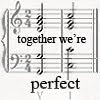So I just finished off a bag of Skittles, 2 sour Starbursts (I think they mucked up the insides of my mouth with their acid nuuuuuu), and a bag of Reese's pieces. I wasn't even hungry, but I wanted to chomp viciously on things and now I can practically hear my teeth crying from the sugar overload.
Before I get down to business (aka Math practice questions ;____;), I'm going to go into Music student mode and blog about something we covered in class today that I found exceptionally mind-blowing. I know that all of the "wannabe Music majors" are probably too busy trying to kick Science course butt to read this, but I'll post it anyway. And blogging about this is probably good review for myself.
I WILL BLOG ABOUT MOAR NORMAL THINGS LATER, BUT RIGHT NOW I NEED TO GET THIS FANGIRLINESS OUT OF MY SYSTEM.
Today we covered imitation and the different types of imitation. There's "lining out" which is monophony (one voice) and is the type of imitation that occurs at a campfire when people sing their little ditties; one voices sings a line which is then repeated/imitated by the other voices, and so on and so forth with each line. The type of imitation that occurs in polyphony (multiple voices) is called the canon. The canon is further broken down into 2 types, but they're irrelevant to this post. We began discussing the most simple kind of canon, which is the round (e.g. Row row row your boat). After a few "a round"/"round" jokes, my prof started talking about mensuration canons. Now, the word "mensuration" generally just denotes measure/time and back in the Middle Ages, mensuration symbols were what told the performers what meter the piece was in. Essentially "mensuration canon" just means a work with multiple voices imitating each other according to the specified meter.
This is where it gets interesting.
So you have your basic staff line with the notes sitting pretty on it, but BAM. Those aren't the only things sitting on those five black lines. There are these little mensuration signs, too. But why, you may be asking, would there be mensuration signS? Well, the thing is... For each mensuration sign, you get another voice singing that part. So you have your first voice, using one mensuration sign singing those notes, and then you have another voice using the next mensuration sign. And you'd think that it'd be a higglety pigglety mess, what with one voice singing at one meter ("normal pace") and another voice singing at a different meter (a pace faster or slower than "normal") but it's not. At least, that's if the composer knows what the hell he/she's doing.
AND THEN THIS IS WHERE IT GETS WEIRDER AND MY JAW WOULDN'T CLOSE IN CLASS BECAUSE HOLY SHIT THIS IS RIVETING STUFF.
My prof had previously posed this question in class: "Was Mozart a genius?" And subsequently, we took two lines/systems of Mozart and ripped them apart and found all the little motives and clever configurations used in just those TWO systems. Of course we concluded that Mozart was indeed a genius (though if you know me then you know that I would've said "HELL YEAH HE'S A GENIUS" long before that~). My prof has also asked whether or not Bartok was a genius and the evidence is not so strong for that one, if I recall correctly, though his string quartets were pretty snazzy with all that chromaticism. So that brings us to today's question: "Was Bach a genius?" And like you knew, the answer is "yes". Now for the evidence...
So these mensuration canons are also known by another (far more appropriate) name: the puzzle canon. And yes, each comes complete with a solution. Now, there's this one type of puzzle canon that I find particularly mind-blowing, and it is the crab canon or cancrizan. In the cancrizan, one voice proceeds normally from start to finish. And the other voice? Oh well, it makes like a crab... and GOES BACKWARDS. Yes. IT STARTS FROM THE END WHERE THE DOUBLE BAR LINES ARE AND GOES BACKWARDS. And you know what? It sounds pretty damn awesome. (If you can get over the jangly yellow quality of the harpsichord.)
Pretty damn cool, if I do say so myself. And what's more, it sounds good! It isn't overly dissonant or awkward or anything! And it just amazes me how Bach just fucking IMPROVISED these things on the spot: "Oh, gotta think of a new cool piece to offer my potential patron. Well, I'm getting on in age and can't be arsed to write him a mass or cantata. Let's just bullshit a little somethin' somethin'."
And there's also the mirror canon, but it doesn't blow my mind as much as the cancrizan does, for some reason. I mean, all you do in a mirror canon is play upside down:
Bach: +10 respect points





0 comments:
Post a Comment
Join the bitchfest!